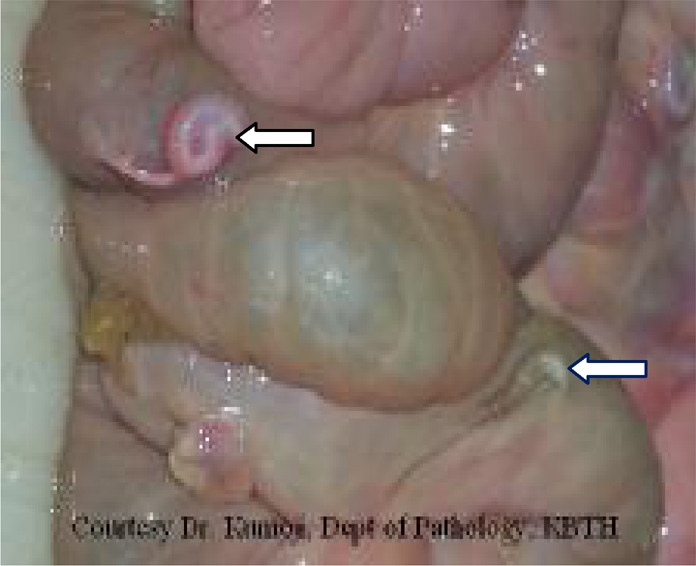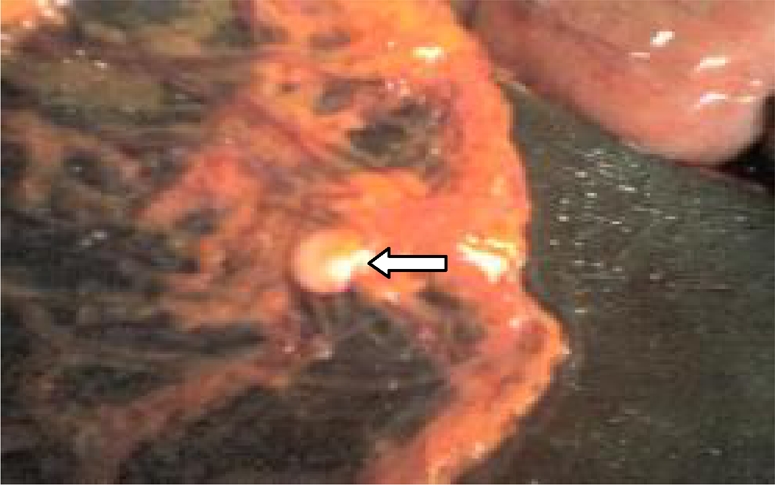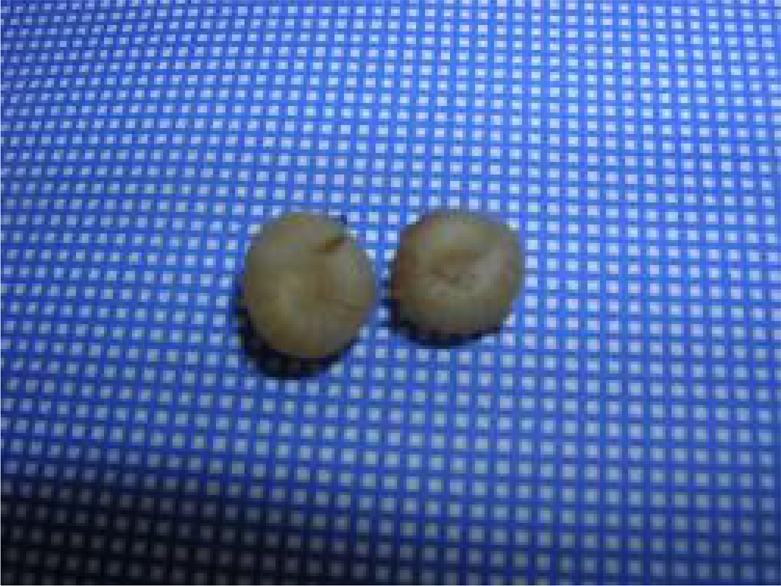Summary
Many tribes in Ghana have totems which they may relate with closely. The python is the totem of many of the tribes in the savanna belt of Ghana. Four cases of human pentastomiasis diagnosed incidentally through surgery and autopsy at the Korle-Bu Teaching Hospital all have the python as their totem and might have been in contact with this creature in the past. The transmission of the parasites to these people probably was directly from infested snake slime to humans.
Keywords: Pentastomisis, Python, zoonosis, Totem
Introduction
Human pentastomiasis is an ancient parasitic zoonosis first reported by Pruner in 1847 and Wyman subsequently identified the parasite in the nasopharynx of the African python in 1848. 1,2 These findings enabled the tracing of the life cycle of the parasite in the wild and the probable modes of human infestation. Pentastomids are blood sucking endoparasites that normally inhabit in the nasopharynx of the python. Embryonated eggs laid by these parasites are discharged through the nasal and faecal discharges of the python and contaminate vegetation and water bodies. In the wild a rodent gets infested from these contaminated sources. When the python feeds on the rodent the life cycle becomes completed. From the python, the rodent, the contaminated environment, other infested herbivores and carnivores man accidentally gets infested. Infestation of man interrupts the life cycle.
Human pantastomiasis was officially first documented in Ghana by Dakubo et al in 2006.3 Following this report three new cases have been identified in Ghana by the authors. While the initial report, just like similar ones noted in the world literature4, speculated on the probable source of direct human infestation there is a socio-cultural circumstance common to the four cases, currently known in Ghana, which probably suggests the mode of transmission of the parasite to these cases.
This paper documents the four cases and describes the socio-cultural relationship, in totemic practice, among the clans of the four cases which might have resulted in the transmission of pentastomids from the python directly to humans whom they are in close contact with in their habitats.
Case Reports
All four cases were diagnosed incidentally, two at surgery in 2004 and 2007 and two at autopsy in 2006. Following the report of the first case consultations were made with the veterinary officers, who examine and certify as wholesome the carcasses of the ruminants killed for consumption, at the abattoirs in Accra to find out if they were encountering animals with pentastomid infestation in their normal daily work. In addition a literature search was undertaken looking for reported cases of pentastomiasis in animals in Ghana.
The two patients who underwent surgery and the relatives of those who were deceased were extensively interviewed about the social life of the patients and the deceased from their birth till the time of their surgery or death. Enquiry was also made into the beliefs of, as well as the relationship that, the clans/tribes to which these patients belonged had with the python.
Table 1 details the characteristics of the four cases and the distribution of the parasites in their abdomen. Case 1 was an Ewe from northern Volta Region who migrated to live in Accra when he was an adolescent, case 2 was a young Mamprusi girl from the northern region who migrated to Accra in search of menial jobs; case 3 was a Frafra (Sirigu) from the Upper East Region who traded in live poultry which he transported from the northern part of the country to Accra to sell; and case 4 was a Tallensi, from the Upper East Region who lived most of his life in Bolgatanga but migrated to Accra five years before diagnosis.
Table 1.
The characteristics of patients and deceased diagnosed with pentastomiasis and the intra-abdominal distribution of the parasites
| Patients characteristics | Case 13 | Case 2 | Case 3 | Case 4 |
| Age (years) | 55 | 9 | 32 | 26 |
| Sex | Male | Female | Male | Male |
| Region of Origin in Ghana |
North Volta | Northern | Upper East | Upper East |
| Tribe | Ewe | Mamprusi (Walawale) | Frafra (Sirigu) | Tallensi |
| Totem | Python | Python | Python | Python |
| Diagnosi | Laparotomy on account of Intestinal obstruction from small bowel stricture |
Autopsy. Patient died from Road Traffic Accident |
Autopsy. Patient died from Varicella pneumonia |
Laparotomy on account of penetrating abdominal injury |
| Distribution of the parasites in the abdomen |
Encysted larvae on jejunum and in omentum, granulomas in the wall of jejunum |
Encysted larvae on whole of small bowel and omentum. Free mobile larva in peritoneal cavity |
Free larva stuck in an intra-hepatic portal vein radicle. |
Encysted larvae in the omentum, the mesentery of jejunum and the surface of the liver |
Ashaiman Agbogbloshie, Nima and South La where these patients resided are sub-urban slums in the Greater Accra Region. In all four cases the python was identified as their totem and to them finding this creature with and among them in their homes was normal.
A search for pentastomids from the ruminants killed at the abattoir and the literature search for published cases from animals in Ghana yielded no results.
Figures 1, 2 and 3 are the pictures of the pentastomid larvae that were found in cases 2 and 4.
Figure 1.

An encysted larva (upper arrow) and a free mobile larva in the peritoneal cavity (lower arrow) of case 2.
Figure 2.

An encysted larva in the omentum (arrowed) of case 4
Figure 3.

Two encysted larvae dissected from the omentum of case 4
Discussion
In the wild, the life cycle of pentastomids goes from the python to vegetation, then a rodent and back to the python, when the rodent is consumed by the python. Other large animals (carnivores) may be infested when they eat infested rodents or by consuming vegetation (herbivores) contaminated with infested snake slime. Accidental human infestation will therefore be directly from the snake slime or faecal droppings (when there is close intimacy between the two), from vegetation that has been contaminated, consumption of rodents or the offal of infested carnivores or herbivores (the Halzoun or Marrara syndrome). It is in the Marrara syndrome (a hypersensitivity reaction to parasite proteins) only that the disease is immediately traceable to the contaminated offal of the ruminant just consumed.5 In all other cases the likely modes of transmission of the parasites have been speculative since infestations have always been long standing and diagnosis made incidentally.
Many clans/tribes in Ghana have totems, which are either animals or plants that the people relate with closely and treat specially.6,7 This practice has nothing to do with superstition6 or primitivism. In the savanna belt, in particular, this system of beliefs and the associated practices bring the python (which is the totem of many tribes in the northern part of Ghana) into close relationship with humans. The Dagaaba of the upper west region8, the Frafra (of Sirigu) 9 and the Tallensi of the upper east region, the Mamprusi of the northern region as well as the Ewes of the Volta Region of Ghana (who accord the python high respect by calling it Togbe Dagbey), all have the python as their totem. The python is therefore treated in special ways by these tribes. It is not killed, harmed or eaten by these clans. If the totem (python) dies accidentally it could be mourned and buried with the same honours as a member of the clan.10
As pertains in the savanna belt of Ghana, when the dwelling places of these creatures are flooded during the heavy rainy season they creep into the mud homes of the people and co-inhabit with them. These snakes occupy spaces in-between pots, cupboards and the woodwork of the landcrete or grass roofing of the buildings during the day. In the night they creep around in the rooms and yard looking for food (mice) and commonly, ultimately, retire onto the mats on which the people will be sleeping.
The connection between the people and their totem is usually mutually beneficial.10 By migrating to live with humans the python gets a dry warm habitat and feeds on mice, which could be many, in the homes. The totem (python) stands for protection for the people.10 In Sirigu (the Frafra) the python is revered, and was worshiped in the past, since it symbolized life and death to the people. The python came to the home to welcome a newly married woman to her husband's home by lying on her lap. When a newborn baby was left alone unattended by a busy mother who was engaged in some other activity outside the home, the python comes to lie by the baby and coils its head in the middle and the tail outside, so it could lull the crying baby to sleep by putting its tail into the baby's mouth to suck (gush). 9
This level of closeness between man and the python will in no doubt increase the risk of direct transmission of embryonated eggs of pentastomids from the snake to man, and in the cases presented, this is a much more probable mode of transmission than the chance occurrence of the transmission from contaminated vegetation or water bodies on the farm. If human infestation were from contaminated vegetation or from water bodies to man this would have shown in the animals killed in the abattoirs in Accra since virtually all these animals are reared in the savanna, where they graze on grass and drink from ponds, and transported to Accra for consumption. The transmission of the parasite by direct contact with the python could be as early in life as infancy. Massive human parasitisation has not been reported in Ghana but this level of closeness will make ingestion of a whole gravid worm easy, a situation that accounted for the two heavy, fatal infestations reported in the literature. 11,12
Conclusion
Human pentastomiasis in Ghana appears to be emerging from clans that have the python as their totem. The totemic relationship enables direct contact with the python thereby increasing the risk of disease transmission if the python is discharging embryonated eggs in its' slime or faecal droppings.
References
- 1.Meyers WM, Neafie RC, Connor DH. Pentastomiasis. In: Binford CH, Connor DH, editors. Pathology of Tropical and extraordinary diseases. Washington DC: Armed Forces Institute of Pathology; 1986. pp. 284–308. [Google Scholar]
- 2.De Meneghi D. Pentastomes (Pentastomiasis, Amillifer armillatus Wyman, 1848) in snakes from Zambia. Parasitogia. 1999;41:573–574. [PubMed] [Google Scholar]
- 3.Dakubo JCB, Etwire VK, Kumoji R, Naaeder SB. Human Pentastomiasis: A case report. West Afr J Med. 2006;25(2):166–168. [PubMed] [Google Scholar]
- 4.Machado MAC, Makdissi FF, Canedo LF, Martino RB, Crecentini F, Chieffi PP, Bacchella T, Machado MC. Unusual case of pentastomiasis mimicking liver tumour. J Gastroenterology and Hepatology. 2006;21(7):1218–1220. doi: 10.1111/j.1440-1746.2006.03203.x. [DOI] [PubMed] [Google Scholar]
- 5.Buslau M, Kuhne U, Marsch WC. Dermatological signs of nasopharyngeal Linguatulosis ( Halzoun, Marrara syndrome) the possible role of a major basic protein. Dermatologica. 1990;181:327–329. doi: 10.1159/000247840. [DOI] [PubMed] [Google Scholar]
- 6.Sarpong PK. Peoples differ: An approach to Inculturation in Evangelisation. Accra: Sub-Saharan Publishers; 2002. Outline of African traditional religion; pp. 94–104. [Google Scholar]
- 7.Nukunya GK. Tradition and change in Ghana: An introduction to sociology. Second Edition. Accra: Ghana Universities Press; 2003. The main features of traditional societies kingship; pp. 17–37. [Google Scholar]
- 8.Bodoma AB. African-Asian Relations: Some Historical, Cultural and linguistic Connections. 2001. Aug 7, Lecture delivered at Anstead University, Penang. Malaysia. [Google Scholar]
- 9.Hawerkort B. Wall to Wall Art and artist of Sirigu Ghana. http://www.bhaverkort.nl/content/htm/publicaties/SWOPA.
- 10.Sigmund Freud, author. James Strachey (Authorized translation) Totem and Taboo: Some points of Agreement between and mental lives of Savages and Neurotics. New York: W. W Norton and Company. Inc; 1950. The return of Totemism in Childhood; pp. 100–161. [Google Scholar]
- 11.Cagnard V, Nocolas-Randegger J, Dago Akribi A, Rain B, Nozais JP, Essoh Nomel P, Ette M, Doucet J, Assale N'Dri G. Generalized and fatal pentastomaisis due to Armillifer Grandis. Bull Soc Pathol Exot filiales. 1979;72:345–352. [PubMed] [Google Scholar]
- 12.Ma KC, Qui MH, Rong YL. Pathological differentiation of suspected cases of pentastomiasis. Trop Med and Int Health. 2002;4:166–177. doi: 10.1046/j.1365-3156.2002.00839.x. [DOI] [PubMed] [Google Scholar]


